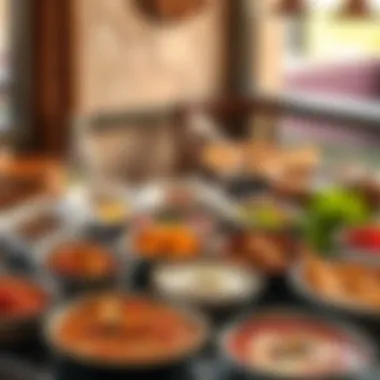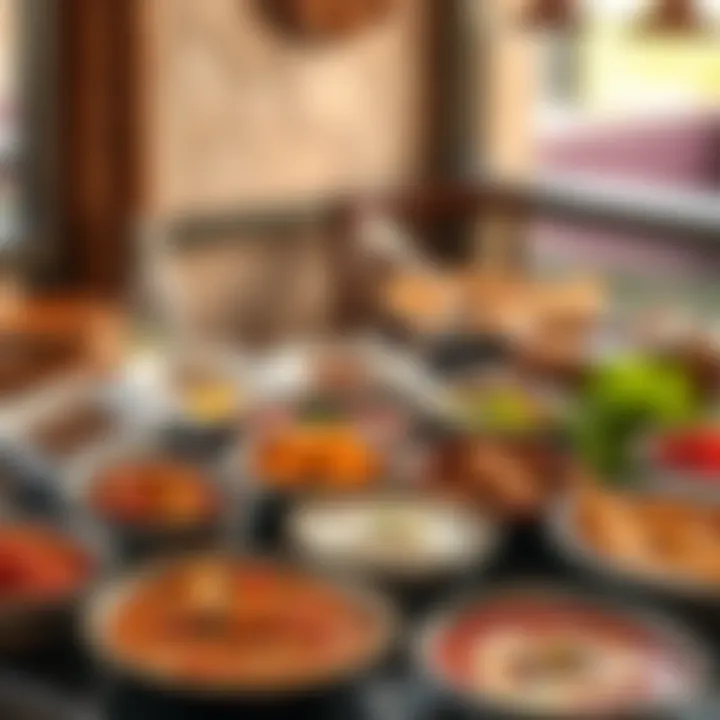Discovering Unique Indian Dining Experiences in Dubai


Intro
Dubai's culinary landscape is a miniature world of flavors, where a diverse array of cuisines flourish in tandem with one another. Among the most prominent is Indian cuisine, which holds a pivotal role in shaping the city’s food scene. With a rich tapestry of spices, cooking techniques, and regional dishes, Indian restaurants in Dubai provide an immersive experience that goes beyond mere dining.
The city is home to more than a few exemplary Indian restaurants, each offering a unique taste of India’s culinary heritage blended with a modern twist. This article will explore some of the exceptional Indian dining establishments that not only highlight traditional fare but also introduce innovative dishes that reflect the evolving palate of Dubai's cosmopolitan population. The significance of Indian cuisine within Dubai extends to its cultural impact, as it serves as a bridge for the Indian diaspora and a gateway for locals and tourists eager to indulge in authentic flavors.
In the following sections, we will delve deeper into various facets of the Indian dining experience in Dubai, examining the ambiance, menu offerings, and the stories behind each restaurant. Further, we will discuss market trends, investment opportunities, and practical tips for those looking to navigate this vibrant food community. Join us as we embark on this culinary journey, peeling back the layers of flavor and tradition that make Indian restaurants in Dubai truly exceptional.
Preface to Indian Cuisine
Indian cuisine isn't just about food; it's a colorful tapestry woven from the threads of history, geography, and socio-cultural dynamics. When diving into the world of Indian dining, one discovers a rich diversity that reflects the multi-faceted nature of its regional identities. This introduction serves to lay the groundwork for understanding why Indian cuisine has found a vibrant home in Dubai and beyond.
The importance of examining Indian cuisine within this article lies in recognizing its uniqueness and the cultural narratives that travel alongside each dish. From the fragrant biryanis of Hyderabad to the fiery curries of the Punjab, the flavors are not merely ingredients on a plate; they represent a way of life, a heritage passed down through generations.
Historical Context
The historical journey of Indian cuisine can be traced back to ancient times, where culinary practices were influenced by a kaleidoscope of invaders, traders, and migrating peoples. Historical texts and archaeological evidence reveal that spices and cooking methods were traded millennia ago, forging connections across Asia and beyond.
For instance, the arrival of the Mughals in the 16th century significantly altered the culinary landscape, introducing techniques and ingredients that have become staples in modern Indian cooking. Tandoori cooking, a popular method today, can be traced back to this era. Even the British colonial presence brought about new adaptations and interactions with local cuisines, birthing dishes like the beloved chicken tikka masala—often considered a British classic now.
Cultural Significance
Food in India is intimately tied to culture and tradition. From festivals to family gatherings, every occasion is punctuated by specific culinary practices. The communal aspect of eating, often experienced during meals—where families gather around a thali, sharing multiple dishes—deepens the connection to each other and to their roots.
Moreover, Indian cuisine is filled with symbolism. For example, the inclusion of specific ingredients, like turmeric, reflects not only health benefits but also beliefs rooted in spirituality and festival celebrations. A plate of sumptuous biryani holds stories of love, tradition, and social gathering.
As Dubai becomes a melting pot of global cultures, its Indian dining establishments replicate these familial and social experiences, allowing expatriates and locals alike to savor tastes that remind them of home, while also adapting to contemporary flair. Thus, Indian cuisine in Dubai is not just about satiating hunger; it's a gateway to understanding a rich cultural heritage and the importance of community.
"Food is a central part of Indian culture. Each meal tells a story, and every flavor has a connection to history."
In summary, understanding Indian cuisine's roots, history, and cultural significance sets the stage for exploring the diverse dining experiences available in Dubai. As we venture further into this article, you'll see how these flavors and stories are expressed and celebrated in this bustling metropolis.
The Indian Dining Experience in Dubai
The dining scene in Dubai is a vibrant tapestry woven from many cultural threads, with Indian cuisine playing a significant role in this rich mosaic. When one walks into an Indian restaurant in Dubai, they are not just entering a food establishment, but stepping into a microcosm of India itself. The Indian dining experience here goes beyond mere sustenance; it encapsulates tradition, hospitality, and a celebration of flavors that span the subcontinent.
Key Elements of the Experience
Ambience and Decor
The ambience of an Indian restaurant in Dubai typically reflects the rich heritage and diversity of India. The decor often incorporates traditional elements such as intricate wood carvings, vibrant fabrics, and ambient lighting that sets a warm mood. Each restaurant might adopt a theme, from the regal grandeur of Rajasthan to the coastal charm of Kerala.
For instance, some establishments use artwork depicting Indian mythology or traditional scenes, creating a fascinating backdrop. Lighting plays a pivotal role, where low, soft glows create an inviting atmosphere that encourages diners to linger. This attention to detail fosters a sense of immersion in Indian culture, making every meal an experience to remember.
"It is often said that you eat with your eyes first; the ambience enhances the overall experience, making the food taste even better."
Moreover, many restaurants offer outdoor seating that lets you soak up the Dubai skyline, adding even more to the dining experience.
Service Standards
Service in Indian restaurants is more than just delivering plates; it's an orchestrated dance of hospitality. In Dubai, where many expatriates and tourists seek authenticity, a warm, professional, and knowledgeable service staff becomes vital.
Staff members often have a rich understanding of the menu, ready to recommend dishes based on individual tastes or dietary restrictions. This personalized approach not only elevates the dining experience but also allows guests to explore new flavors with confidence.
They may suggest popular dishes like Biryani, which can vary widely depending on the region, or provide insights into the spice levels tailored to each diner's palate.
Additionally, many restaurants emphasize the art of dining as a communal experience, encouraging patrons to share dishes. This practice mirrors the Indian tradition of family-style dining, where everyone savors a variety of flavors, enhancing community ties and creating a more engaging, convivial atmosphere.
In summary, to step into an Indian restaurant in Dubai is to engage all the senses. The combination of thoughtful ambience, stunning decor, and exemplary service captures the essence of Indian hospitality. For residents and expatriates seeking a taste of home, or newcomers eager to experience the depth of Indian cuisine, these elements create a unique dining experience that is hard to forget.
Noteworthy Indian Restaurants
When exploring the unique culinary landscape of Dubai, it is impossible to overlook the impact and significance of standout Indian restaurants. This category encapsulates a spectrum of dining experiences ranging from the extravagant to the comfortably relaxed. These venues do more than just serve food; they encapsulate a culture, tell a story, and invite patrons to partake in a journey through Indian cuisine.
Fine Dining Experiences
In the realm of fine dining, Indian restaurants in Dubai are pushing the boundaries of what is considered traditional cuisine. Establishments such as Rang Mahal or Zafran Indian Bistro invite guests to relish multiple-course meals that are often paired with exquisite wines or craft cocktails. The combination of vibrant flavors and upscale presentations creates an experience that feels regal.
The atmosphere is meticulously crafted. Expect to walk into spaces adorned with elegant décor, soft ambient lighting, and attentive staff members who elevate your dining experience. For example, at At.mosphere, located on the 122nd floor of the Burj Khalifa, the view complements the meal, enhancing its worth several fold.
"In fine dining, it’s not just about food; it’s about craftsmanship and attention to detail."
Casual Dining Options


On the other end of the spectrum lie casual dining venues, which do not skimp on authenticity or flavor. Indian cuisine shines brightly in establishments such as Indian Dhaba or Biryani Pot. These places offer a laid-back environment where the vibrancy of Indian culture can be appreciated without the frills of upscale dining. The menus are often extensive, covering regional dishes that cater to a variety of palates.
Eating here feels like lounging at a friend's home rather than sitting at a restaurant. Family-style shares are common, allowing guests to sample an array of dishes from creamy butter chicken to tangy chaatos. This reflects the notion that food is inherently communal in Indian culture.
Street Food Inspirations
Street food often serves as the heart of any culinary exploration, and this holds true for Indian cuisine in Dubai. Several notable restaurants pull inspiration from the vibrant streets of India to create immersive experiences that dive into the flavors of urban Indian life. Places like Chatkazz and Aamchi Mumbai offer a plethora of street food options such as pav bhaji and vada pav, appealing to both nostalgia and adventurous culinary appetites.
Here, the hustle and bustle mimic the lively street corners of Mumbai, creating an engaging backdrop for dining. The idea is to infuse the dining space with the essence of Indian streets, complete with festooned lights and boisterous chatter. You can find the spirit of India captured in every bite, as if the chefs have worked diligently to transport authentic street-savory fare into a restaurant setting.
In summary, the array of noteworthy Indian restaurants in Dubai—for dining finely, casually, or street-style—captures the essence of Indian cuisine while adapting to local tastes and preferences. Each venue contributes a piece of India’s rich tapestry, ensuring that every culinary journey is distinctly memorable.
Regional Specialties
The rich tapestry of Indian cuisine is not just an ensemble of flavors; it is a reflection of the diverse regions it hails from. Understanding Regional Specialties is crucial in any discussion about Indian restaurants in Dubai, as it allows diners to appreciate the profound culinary heritage and the unique elements each region contributes to the table.
Importance of Regional Specialties
By delving into regional specialties, we gain insight into the food culture shaped by history, geography, and the local climate. Each region in India boasts its own distinctive techniques, ingredients, and flavors that have evolved over centuries. This variety ensures that when one explores Indian cuisine, it is an adventure through different landscapes and narratives. From the richly spiced dishes of the North to the tangy, coconut-infused meals of the South, the contrast is palpable and delightful.
Benefits of Emphasizing Regional Specialties
- Authenticity: Restaurants focusing on regional specialties tend to offer an authentic dining experience. Dishes made by chefs who hail from these regions can transport diners to a small village banquet, showcasing tastes that are not commonly found in generic Indian fare.
- Cultural Appreciation: Exploring these specialties fosters an appreciation for the diverse cultures within India. Each dish tells a story, reflecting local traditions, customs, and even festivals.
- Fresh Ingredients: Many dishes spotlight the seasonal ingredients native to their respective regions, which enhances flavor and freshness. It encourages sustainable eating, as local restaurants often source their produce from nearby vendors.
- Variety: With a vast array of dishes to explore, diners are in for a treat. Whether one is seeking warming curries, crispy dosas, or fragrant biryanis, each meal can be a unique flavor expedition.
In essence, the exploration of regional specialties forms a backbone of the Indian culinary experience in Dubai.
North Indian Dishes
In Northern India, the cuisine is characterized by a diverse array of rich and hearty dishes. This region features staples such as paneer, a fresh cheese that plays a central role in vegetarian dishes, and naan, the beloved flatbread. Moreover, slow-cooked meats in gravies, like the famous butter chicken, exemplify the culinary prowess honed through generations. Each dish typically incorporates a blend of spices, with cumin, coriander, and garam masala acting as the cornerstone of flavor combinations.
South Indian Flavors
Conversely, South Indian cuisine leans heavily on rice and lentils, introducing a dazzling array of fermented dishes such as idli and dosa. The use of coconut, both grated and in oil form, provides a distinct taste. South Indian meals are often accompanied by tangy sambar and a variety of chutneys that add to the overall flavor profile. The hallmark of this cuisine lies in its vibrant use of spices, which may differ dramatically from those used in the North, creating an experience that is delightfully diverse.
Western Indian Influences
Western Indian cuisine showcases a medley of flavors and styles, with dishes varying from the rich seafood curry of Goa to the hearty, wholesome vegetarian meals of Gujarat. The presence of coconut, jaggery, and a plethora of spices makes this cuisine highly regarded. Dishes such as dhokla and prawn curry underscore this area’s culinary diversity, providing a wonderful balancing act of sweet and savory.
"In every bite, there is a piece of history, culture, and tradition that showcases the essence of India’s culinary heritage."
Through this regional exploration, patrons in Dubai can discover the depth of Indian cuisine, turning each meal into an enriching encounter with culture and flavor.
Fusion and Innovation in Indian Cuisine
Fusion and innovation are vital themes in today’s culinary landscape, particularly within Indian cuisine. In a city like Dubai, where cultures converge, the blending of traditional Indian with global flavors creates unique dining experiences that captivate a diverse audience. Understanding these elements is crucial for anyone navigating the restaurant scene here.
Modern Twists on Tradition
Modern twists on tradition can be seen in many Indian restaurants across Dubai. Chefs take classic dishes, like butter chicken or biryani, and infuse them with ingredients or techniques from other cuisines. For instance, you might find a butter chicken taco at a trendy eatery or a sushi roll filled with spiced lentils. These iterations don't just cater to evolving tastes; they also showcase the chefs' creativity and willingness to experiment.
Adapting traditional recipes to suit the global palate can bring a fresh perspective without losing the essence of the original dish. However, the delicate balance between maintaining authenticity and inviting innovation is key. Diners often have a fondness for nostalgic flavors, yet they are also eager to explore new experiences. This dual desire keeps restaurants on their toes, pushing boundaries while respecting the rich heritage of Indian cuisine.
Influence of Global Trends
Global trends significantly impact how Indian cuisine is experienced in Dubai. With an increasingly health-conscious population, you can see a rise in restaurant offerings emphasizing organic ingredients. Many establishments now proudly feature locally sourced vegetables or sustainable seafood in their dishes, aligning with the global shift towards healthier eating habits.
Moreover, social media plays a substantial role in shaping dining trends. The rise of platforms like Instagram has encouraged restaurants to create visually stunning dishes that not only taste good but also look appealing. Food presentation becomes part of the dining experience, pushing chefs to think creatively about plating and garnishing.
Additionally, collaborations between chefs from different backgrounds have led to exciting ventures, creating menus unique to Dubai's melting pot of cultures. Fusion cuisine isn’t merely a passing phase; it reflects the evolving identity of Indian food as it interacts with the global culinary scene. This interplay between global influences and local traditions results in a dining experience that is both familiar and exotic, catering to a wide range of tastes.
"The beauty of Indian cuisine is its adaptability and the endless possibilities for creativity, particularly in a city as diverse as Dubai."
In essence, the importance of fusion and innovation in Indian cuisine cannot be overstated. These concepts not only enhance the overall dining experience but also tell a story of cultural exchange and culinary evolution that resonates with both residents and visitors alike.
Vegetarian and Vegan Offerings
Indian cuisine has a long-standing tradition of vegetarianism, deeply rooted in cultural, religious, and ethical considerations. As more people opt for plant-based diets, the significance of vegetarian and vegan offerings in Indian restaurants has become increasingly relevant, especially in a melting pot like Dubai. This city is a beacon of culinary diversity, and the wide array of vegetarian and vegan options caters not just to followers of these diets but also to food enthusiasts looking for healthy, flavorful dishes.
Traditional Vegetarian Cuisine
In Indian culture, vegetarianism isn’t merely a dietary choice, it is often a way of life. Traditional Indian vegetarian cuisine features an impressive palette of flavors, colors, and textures that can entice even the most ardent carnivores. Dishes such as paneer makhani, dal tadka, and chole bhature reflect this creativity. Each regional specialty showcases different ingredients and cooking techniques, making vegetarian offerings a feast for the senses.
- Paneer Makhanwala: This North Indian dish consists of cottage cheese cooked in a creamy, tomato-based gravy, often garnished with a drizzle of fresh cream and coriander.
- Bhindi Masala: Fresh okra cooked with spices reflects the hearty yet simple cooking styles in many Indian homes.
- Sambar: A South Indian staple made with lentils and vegetables, this spicy and tangy dish pairs perfectly with rice or idli.


Such variations allow vegetarians and vegans alike to enjoy a myriad of healthy and delicious options. The spices and herbs not only enhance flavor but also contribute nutritional benefits, making Indian vegetarian cuisine an excellent choice for maintaining a balanced diet.
Vegan-Friendly Dishes
With the rise of veganism across the globe, Dubai's Indian restaurants have begun to cater to this demand diligently. Vegan-friendly dishes are no longer an afterthought but instead play a crucial role in the contemporary dining landscape. Restaurant chefs are adopting innovative techniques to craft meals that not only fulfill dietary restrictions but also retain authentic flavors.
Examples of vegan dishes gaining popularity include:
- Vegan Biryani: This fragrant rice dish incorporates seasonal vegetables and is seasoned with saffron and an array of spices, ensuring that flavor does not take a backseat even when meat is omitted.
- Aloo Gobi: A classic mix of spiced potatoes and cauliflower, garnished with fresh herbs and served with flatbreads, making it a satisfying option for any meal.
- Coconut Curry: A creamy, rich base made with coconut milk and an assortment of vegetables means that vegan diners don’t miss out on the luxurious textures typically associated with Indian cuisine.
In addition to these dishes, many restaurants now offer customizable vegan options, allowing diners to tailor their meals to fit their specific preferences. This trend reflects a broader movement towards inclusivity in dining, where flavor is key but meeting dietary needs is equally prioritized.
"The beauty of Indian vegetarian and vegan cuisine lies in its rich diversity and adaptability; there's truly something for every palate."
Cooking Techniques and Ingredients
When diving into the world of Indian cuisine, one cannot overlook the intricate cooking techniques and the rich tapestry of ingredients used in preparing dishes. These elements play a pivotal role in defining the flavors, textures, and overall dining experience at Indian restaurants in Dubai. Understanding these techniques and ingredients not only enhances the appreciation of the cuisine but also reflects its historical and cultural evolution.
The Use of Spices
Spices are akin to the lifeblood of Indian cooking. They offer depth and complexity, transforming simple dishes into something remarkable. The spice box, or masala dabba, typically contains a variety of spices such as cumin, coriander, turmeric, and garam masala. Each spice has its own story and purpose, contributing to the aromatics and flavors of the dishes.
- Health Benefits: Beyond flavor, many spices bring health benefits. For instance, turmeric is known for its anti-inflammatory properties, while cumin aids digestion.
- Regional Variations: Different regions of India utilize distinct spices. A dish from Punjab might favor rich, creamy flavors combined with spices like fenugreek, while a South Indian curry might focus more on coconut and mustard seeds.
The way spices are incorporated—whether whole, crushed, or ground—can significantly alter a dish. Sometimes, they are tempered in hot oil at the start, releasing their essential oils to infuse the dish with flavor. Other times, they might be blended into a paste for a more integrated flavor profile. In Dubai, restaurants may enhance this traditional approach by introducing local spices, creating exciting fusion flavors that cater to diverse palates.
Preparation Methods
The preparation methods employed in Indian cooking are as varied as the cuisine itself. Different techniques bring out unique flavors and textures in dishes that keep the dining experience vibrant and interesting.
- Tandoor Cooking: This method is famous for producing beautifully charred meats and naan bread. The high heat of the tandoor oven caramelizes the surfaces, imparting a smoky flavor that is hard to replicate in other cooking methods.
- Slow Cooking: Many Indian dishes benefit from slow cooking, which allows the spices to develop and intensify. For example, biryanis and certain curries thrive on this technique, leading to intricate flavor layers.
- Frying & Tempering: Frying or tempering spices in oil before adding them to a dish is a common practice. This technique not only brings out the flavors but also enhances the aroma, creating an inviting atmosphere for diners.
- Steaming: While less common, steaming is used for foods like idli (fermented rice cakes) or dhokla (savory steamed cake) to retain nutrients and achieve a soft texture.
The methods of preparation also reflect a restaurant's ethos, as some establishments prefer traditional techniques while others might adapt to contemporary culinary practices. This blend of old and new often attracts both lifelong fans of Indian cuisine and new diners eager to explore its many dimensions.
"The secret to Indian cooking lies in the meticulous balance of spices and the care put into preparation, resulting in dishes that tell a story."
In summary, the focus on cooking techniques and ingredients showcases the heart of Indian culinary arts. In Dubai’s vibrant scene, where global influences meet traditional roots, discerning diners have the opportunity to relish an exceptional array of flavors and stories, making every dining experience deeply memorable.
For further exploration of these topics, consider checking resources like Wikipedia or Britannica.
Pairing Drinks with Indian Cuisine
When we talk about Indian cuisine, we're not just referring to the amazing array of flavorful dishes. There is a whole world of beverages that can elevate these meals to a different level. Pairing drinks with Indian cuisine is crucial not only for complementing the rich and varied flavors of the food but also for enhancing the overall dining experience. This careful selection can bring balance to the spices and textures on the plate, making for a more satisfying meal.
First off, the categorization of beverages is essential. Traditional options often have roots in the culture and history of India, while modern mixology presents a creative spin on these classics. Each offering holds significance and can serve as a conversation starter among diners. It’s fascinating how a well-chosen drink can amplify the flavor profiles of dishes — from mitigating heat to enhancing sweetness or acidity.
Traditional Beverage Options
Traditional beverages often feature local ingredients that resonate well with Indian cuisine. Here are some noteworthy selections:
- Masala Chai: This spiced tea is a staple in Indian households. Brewed with a mix of spices such as ginger, cardamom, and cinnamon, it is perfect for cutting through rich curries.
- Lassi: This yogurt-based drink can either be sweet or savory. Depending on which dish is served, a sweet lassi can help balance spicy foods, while a salted version goes extremely well with heavier, spicy curries.
- Nimbu Pani: Made with fresh lemon juice, water, and sugar or salt, nimbu pani is refreshing and can cleanse the palate amidst strong flavors.
These classic options reflect Indian culture and can be found in various restaurants throughout Dubai. Many places prepare them authentically, which adds another layer to the dining adventure.
Modern Mixology
With such a melting pot of cultures in Dubai, the influence of modern mixology cannot be overlooked. Bartenders use the spices and ingredients common in Indian cuisine to create unique cocktails that entice and surprise. Here are some examples:
- Spiced Mojito: A refreshing twist on the traditional mojito, this drink incorporates mint, lime, and ginger, creating a balance that pairs beautifully with grilled dishes.
- Tamarind Whisky Sour: Adding tamarind to a classic whisky sour gives it an Indian flair while maintaining its familiar taste. Tamarind’s tanginess works well to offset the richness often found in Indian meals.
- Chili Mango Margarita: This cocktail is all about blending the sweet and spicy—ripe mango with a hint of chili. It’s an excellent match for zesty appetizers.
Introducing these innovative drinks not only showcases the versatility of Indian flavors but also highlights how traditional inspirations can influence contemporary creations.
Pairing drinks with Indian cuisine is not just about clinking glasses; it’s about enhancing flavors and enriching the culinary journey.
Whether savoring traditional masala chai or delighting in a chili mango margarita, the right beverage can take the meal to astonishing heights. When dining at some of Dubai's exceptional Indian restaurants, patrons should always keep an eye open for drink pairings that are thoughtfully designed to elevate their experience.
Reservations and Pricing
When venturing into the realm of Indian dining in Dubai, understanding the nuances surrounding reservations and pricing is paramount. With a kaleidoscope of culinary options, each restaurant comes with its unique ambiance, pricing dynamics, and reservation policies. These elements not only enhance the dining experience but also significantly impact your culinary adventure. Ensuring you make a reservation at the right time and understanding the pricing structures can elevate your meal from a simple dinner to an unforgettable event.
Understanding Pricing Structures
Diving into the specifics of pricing can feel like navigating through a maze, especially for new diners. Indian restaurants in Dubai generally fall into categories based on the dining experience they offer:


- Fine Dining: These establishments often charge higher prices, reflecting the quality of food, service, and ambience. Dishes might include intricate preparations and premium ingredients, making the cost justified.
- Casual Dining: Here, you might find more accessible prices, offering comfort food that’s as delightful for the taste buds as it is friendly on the wallet. Expect to find a variety of traditional dishes with a casual presentation.
- Street Food Options: Drawing inspiration from India’s bustling street-side eateries, these meals are wallet-friendly and packed with authenticity. Prices tend to be lower, catering to a diverse clientele who want to experience traditional flavors without breaking the bank.
"Understanding the price point not only helps you budget but also sets expectations. Knowing what to expect allows you to enjoy the meal without worrying about the bill."
Each restaurant usually lists their menu prices clearly, allowing diners to assess what fits their budget prior to arrival. It's also wise to check for any special deals or promotions, particularly during festive occasions or pivotal events, as many restaurants in Dubai take this opportunity to entice customers.
When to Reserve a Table
Timing your reservation can make or break your evening out. Many Indian restaurants in Dubai experience peak hours, especially during weekends and holidays. Here are some practical tips to help you snag that coveted seat:
- Plan Ahead: Aim to make your reservations at least a week in advance, especially if you're eyeing a limited-edition dish or a popular venue. Many spots can fill up quickly, and you wouldn't want to miss out on a coveted dining experience.
- Consider Off-Peak Times: If flexibility allows, consider dining during off-peak hours. Early dinners or late lunches can be a treat, offering a quieter dining atmosphere along with easier booking options.
- Online Reservations: Making use of the restaurant's online booking system can be more efficient than calling. This not only saves time but also gives you a direct view of available time slots.
- Special Occasions: If your visit coincides with a special occasion, such as Diwali or a private celebration, it's wise to book well in advance. Many restaurants offer special menus or events that can require early reservations.
Customer Reviews and Feedback
In the realm of dining, especially in a vibrant culinary hub like Dubai, customer reviews hold monumental value. They serve as a critical window into the experiences patrons have, adding layers of depth that a menu or even a restaurant’s own marketing can’t convey. Reviews can illuminate the subtleties of flavor profiles, the diligence of service, or the atmospheric nuances that either enhance or detract from a meal.
Importance of Reviews
Understanding why reviews matter is essential for anyone considering a visit to an Indian restaurant in Dubai. Firstly, reviews offer insight into the authenticity of the cuisine. For instance, when a diner raves about the richness of a butter chicken or the delicateness of a dosa, it indicates not only satisfaction but also culinary authenticity. Often, expatriates from India or well-versed foodies leave their detailed impressions that help others gauge whether a restaurant captures true Indian flavors.
Moreover, reviews can act as a form of social proof. A place bustling with positive feedback often attracts more customers. If you see a restaurant garnering consistent praise for its naan bread or paneer tikka, it piques curiosity and encourages others to experience the same. Additionally, platforms like Facebook and Reddit often host vibrant discussions where enthusiasts share their insights, promoting community engagement and trust.
Consider this: a recent review described Bukhara as a symphony of spices, highlighting how the traditional ingredients transported diners right back to India. Such narratives, brimming with enthusiasm, speak volumes to potential customers. It is a blend of individual stories and opinions that coalesce to create a more informed dining choice.
Evaluating Dining Experiences
Ultimately, the evaluation of dining experiences often stems from these very reviews. A multifaceted review will detail not just the food but also service quality and ambiance, allowing prospective diners to paint a picture of what awaits them. For example, a review might state, "The service was impeccable at Moti Mahal, enhancing the meal with thoughtful recommendations and attentiveness."
When assessing feedback, here are some key considerations:
- Balance of Feedback: One or two negative comments amid a sea of glowing reviews can indicate outliers; however, if consistent issues are noted, it’s worth taking seriously.
- Specificity: Vague positives like "good food" don't carry much weight. Look for specifics, such as comments on the char on a grill or the spice level of a curry.
- Timeliness: Recently posted reviews are often more relevant, as they reflect the current state of the restaurant.
Challenges in the Restaurant Industry
The restaurant industry, particularly in a multicultural hub like Dubai, faces a unique set of challenges that can significantly impact operations and customer satisfaction. Navigating these obstacles is crucial for any Indian restaurant aiming to thrive. These challenges are not mere bumps in the road; they are intricate dynamics that can shape the very fabric of a dining experience. Understanding them helps both restaurant owners and patrons appreciate the efforts behind every meal and service.
Adapting to Market Changes
Market dynamics are constantly shifting. Indian restaurants in Dubai must adapt to a rapidly changing landscape influenced by various factors. The rise of health-conscious diners, for instance, has led many establishments to rethink their menus. Traditional curries are now often paired with lighter, organic ingredients or even plant-based alternatives. As tastes evolve, restaurateurs need to stay ahead of the curve, reflecting these preferences in their offerings.
Moreover, seasonal trends can dictate what diners are craving at different times of the year. For example, during cooler months, customers might lean towards heartier dishes that warm the soul. Conversely, during the peak of summer, refreshing salads and chilled beverages might steal the spotlight. Flexibility is paramount.
Establishments must also consider their target audience. With a significant expatriate population, foreign influences shape dining preferences. Restaurants cannot rely solely on traditional Indian fare; they have to incorporate global culinary trends to attract a diverse clientele. This balancing act requires a keen sense of market trends and continuous customer engagement to gather feedback.
Maintaining Authenticity
While adapting to market changes, staying true to culinary roots becomes an equally pressing challenge. The essence of Indian cuisine lies in its rich traditions and authentic flavors. With pressure to innovate, some restaurants might stray too far from their origins, leading to what critics might call a dilution of cultural identity.
For instance, consider the growing popularity of fusion dishes. While creativity in the kitchen can be delightful, an excess of such offerings may leave customers craving the real thing. Maintaining authenticity involves serving traditional recipes with genuine ingredients prepared using time-honored techniques. It’s what gives a restaurant its soul.
Moreover, the emphasis on authenticity isn’t just about the food; it extends to the overall experience. The warmth of service, the ambiance that reflects cultural heritage, and the commitment to showcase Indian hospitality are paramount. When customers step into an Indian restaurant in Dubai, they should feel transported to India, if only for a meal.
"In every dish, there lies a story that connects the past with the present. Keeping that story alive is crucial."
To summarize, balancing the scales between adapting to market demands and preserving authenticity presents an ongoing challenge for Indian restaurants in Dubai. These challenges, when navigated effectively, not only enhance the dining experience but also bolster the restaurant’s reputation and sustainability in the long run.
Continuing Evolution of Indian Restaurants
The landscape of Indian restaurants in Dubai has shifted significantly over the years, making the continuing evolution of Indian restaurants a topic ripe for exploration. As this culinary scene adapts to new trends and tastes, it reflects not only the preferences of diners but also broader shifts influenced by globalization and innovation. Understanding this evolution provides insight into how Indian cuisine maintains its integrity while embracing new flavors and techniques.
This metamorphosis involves several key elements:
- Diversifying Menus: Restaurants are broadening their offerings beyond traditional dishes. Contemporary adaptations now feature fusion items that reflect global influences, from Indian-inspired sushi rolls to classic biryanis with a Mediterranean twist.
- Culinary Techniques: Chefs are experimenting with modern cooking techniques. Sous-vide cooking, molecular gastronomy, and smoke infusions are being integrated into traditionally rich cuisines, providing guests with a unique sensory experience.
- Sustainability Focus: As diners become more environmentally conscious, many establishments are focusing on sustainable practices. This may include sourcing local ingredients, minimizing waste, or incorporating plant-based options into the menu, catering not just to vegetarians but also to the growing vegan crowd.
In essence, the evolution is about enhancing the dining experience while honoring traditional roots. Every change brings an opportunity to engage new customers and retain old ones.
Emerging Trends
As Indian restaurants navigate this continual evolution, several exciting trends are emerging in Dubai:
- Street Food Revolution: High-end restaurants are borrowing elements from street food culture, serving up small plates and tapas that emphasize bold flavors and casual dining. Think of a gourmet take on paani puri or a deconstructed samosa.
- Cultural Fusion: With a cosmopolitan clientele, restaurants are blending Indian dishes with flavors from other cuisines, resulting in innovative fare like Tandoori tacos or Coconut curry ramen. These dishes blend Indian spices with various culinary traditions, appealing to a diverse audience.
- Experiential Dining: More than just a place to eat, restaurants are now creating experiences. Many offer cooking classes, chef's tables, and interactive dining options where guests can participate actively, deepening their connection with the cuisine.
These trends not only showcase how Indian cuisine can evolve but also how it stays relevant and appealing to future diners.
Future Directions
Looking ahead, several directions appear to be shaping the future of Indian restaurants in Dubai:
- Digital Enhancements: Technology is making waves in the dining industry, from reservation apps to digital menus that include engaging stories about the dishes. Restaurants are now leveraging online platforms to connect with their audience more effectively.
- Health-Conscious Offerings: As health trends continue to rise, Indian cuisine will likely adapt further to include wholesome options. Expect to see dishes featuring superfoods, gluten-free options, and a focus on heart-healthy cooking methods.
- Global Recognition: The recognition of Indian cuisine on global platforms is growing, and restaurants are likely to capitalize on this trend by promoting their chefs and stories of their heritage, establishing connections that resonate beyond borders.



